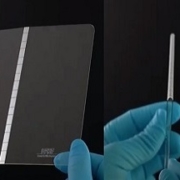LPKF’s laser glass processing technology, makes a cover glass thicker than UTG be folded.
It was expected that the S Pen would be applied to Samsung’s ‘Galaxy Z Fold2’, which will be released in the second half of this year, but it has passed the year.
UTG, the cover window material currently applied to Samsung Electronics’ ‘Galaxy Z Filp’, is 30 um thick and is 1/10 thinner than 300 um, the thickness of commercially available cover glass.
It was possible to have flexibility by using UTG into a foldable phone, but due to the film-like characteristics, there was an issue that durability was insufficient to apply the S Pen.
In order to handle this issue, a technology that increases the thickness of UTG and secures flexibility will be needed. A typical method is processing the folding part of the glass to get flexibility even at a thick thickness.
LIDE (Laser induced deep etching) technology, developed and patented by German high-tech company LPKF, is expected to be a good example. It is known that this technology is a two-step process called micro-region transformation and chemical treatment using a laser, and can process glass of various thicknesses from 30 um to 900 um without micro crack.
LPKF explains that the part where the cover glass is folded is finely processed with a laser to give flexibility to the glass, and it is possible to design the pattern to be invisible using a polymer having same reflectivity as a cover glass.
If you look at Vitrion’s YouTube video (https://youtu.be/Vh3rU4LRHaw), a separate brand related to LIDE, in LPKF, you can see that a cover glass with a thickness of 500 um was patterned to secure bending radius of 1 mm.

<LPKF foldable OLED cover glass, Source: LPKF>
With this glass processing technology, attention is paid to whether a S-pen can be supported as a thicker cover glass is applied to a foldable phone in the future.



